Microlearning is an instructional approach that breaks down complex skill-building into fun, manageable chunks, allowing learners to gain knowledge in small, focused bursts. With social media shrinking attention spans and modern life offering little time for new skills, traditional learning often falls short. That's why platforms like GoSkills leverage microlearning to make upskilling more digestible.
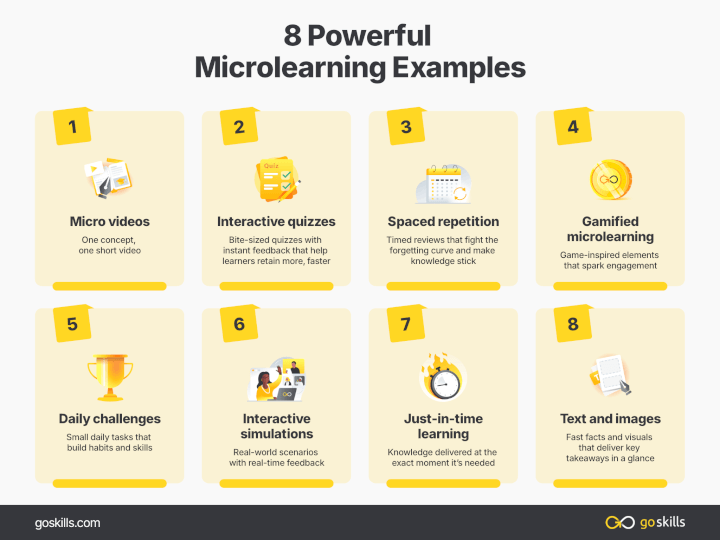
Within the GoSkills LMS, microlearning techniques integrate so seamlessly you might not even notice their presence. This article solidifies the microlearning concept and then explores 9 compelling examples used in the platform:
- Micro videos
- Interactive quizzes
- Spaced repetition
- Gamified microlearning
- Daily Challenges
- Interactive simulations
- Just-in-time learning
- Text and images
Bonus: Skill tree progression
For an authoritative answer to the question, "What is microlearning?" GoSkills consulted Dr. Karl Kapp, a renowned expert in learning technologies, a professor of instructional technology at Bloomsburg University, the co-author of Microlearning: Short and Sweet, and author of the bestselling The Gamification of Learning and Instruction.

Dr. Kapp articulates:
The power of microlearning lies in its deliberate focus: small, concentrated instruction meticulously crafted for an actionable outcome. It's never random content fragmentation, but a precise tool for better recall, task completion, and behavioral change.
— Dr. Karl Kapp, author of Microlearning: Short and Sweet
At GoSkills, microlearning lessons are typically 3-6 minutes long and are often made up of rich media like videos, quizzes, and games.
Microlearning examples
Microlearning is not a new concept. As Dr. Karl Kapp notes in Microlearning: Short and Sweet, "Its application has simply grown with the advent of mobile technology... If you count flash cards as a form of microlearning, it goes back to the 1800s or 1900s."

Dr. Kapp, mentioned above, stressed that microlearning is about more than delivering bite-sized content. As an example, in 2011, Duolingo brought language learning to the masses with bite-sized lessons, progress bars, achievement awards, and its signature adaptive spaced repetition system (reintroducing concepts at optimal intervals for long-term retention).
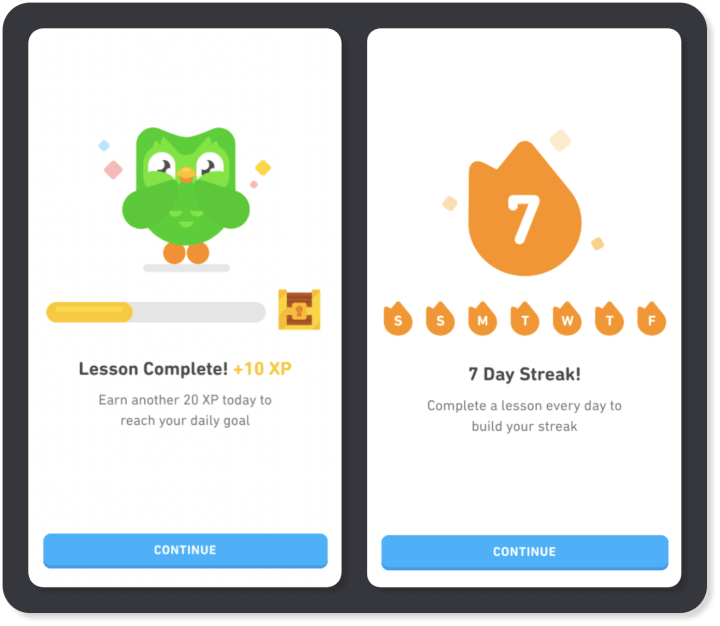
Fast-forwarding to 2025, the following examples illustrate the enduring power of microlearning principles. Skim through the following examples to gain a new appreciation for the subtle microlearning tweaks that make learning fun, engaging, and rewarding.
1. Micro videos
Platforms like TikTok and YouTube Shorts offer short-form video, but prioritize entertainment or general narrative over focused instruction. This makes them inaccurate examples of true microlearning. In contrast, effective micro-videos for learning are characterized by specific pedagogical design.
For instance, micro-videos within GoSkills' Storytelling for Speaking and Presentations are typically 2-4 minutes long. Each video focuses on a single "microskill" necessary for progression, and is followed by a short quiz to reinforce understanding. This structured format is ideal for microlearning due to its:
- Optimal length: Facilitates absorption of single concepts without cognitive overload, fitting short attention spans and quick learning sessions.
- Single concept focus: Ensures clarity by dedicating each brief video to one specific learning objective or skill.
- Immediate reinforcement: Quizzes provide instant feedback, strengthening retention and highlighting areas for improvement, creating a powerful, self-contained learning loop.
Micro-video learning effect: Micro-videos are a quintessential microlearning format. Their inherent brevity enforces a single learning objective per video, making content highly digestible. When paired with immediate assessment, they support rapid comprehension, retention, and application of specific knowledge or skills in bite-sized chunks.
2. Interactive quizzes
Short lessons paired with quizzes make learning easy and boost retention. As an example, Walmart partnered with Axonify on a 6-month safety training pilot program in 2012. Today, the program trains 75,000 Wal-Mart associates across 150-plus U.S. centers. Microlearning concepts powered Axonify's success.

Every day, Walmart associates log in to spend a few minutes completing quizzes. The system provides instant feedback, showing how they measure up against their peers.
On subsequent logins, the system remembers past responses. It begins each session by reinforcing known information and following up on areas where learners need improvement, ensuring continuous, adaptive learning.
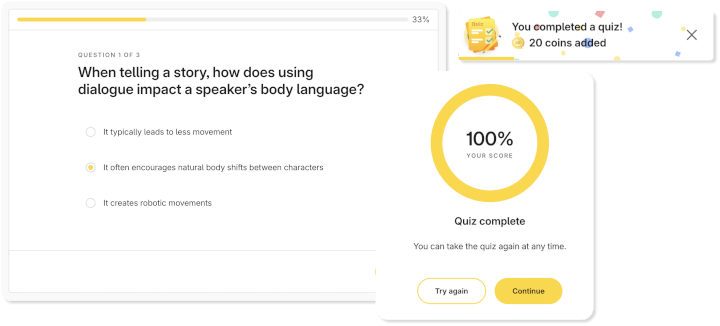
Microlearning quizzes effect: Interactive quizzes are a core microlearning tool, offering bite-sized, active learning experiences. Their short, focused nature allows for immediate knowledge checks on specific concepts or skills, with instant feedback reinforcing understanding and quickly highlighting areas for improvement. This rapid feedback loop and concise format make them ideal for quick comprehension assessment and knowledge retention.
3. Spaced repetition
Hundreds of studies in cognitive and educational psychology have demonstrated that spacing out repeated encounters with the material over time produces superior long-term learning, compared with repetitions that are massed together.
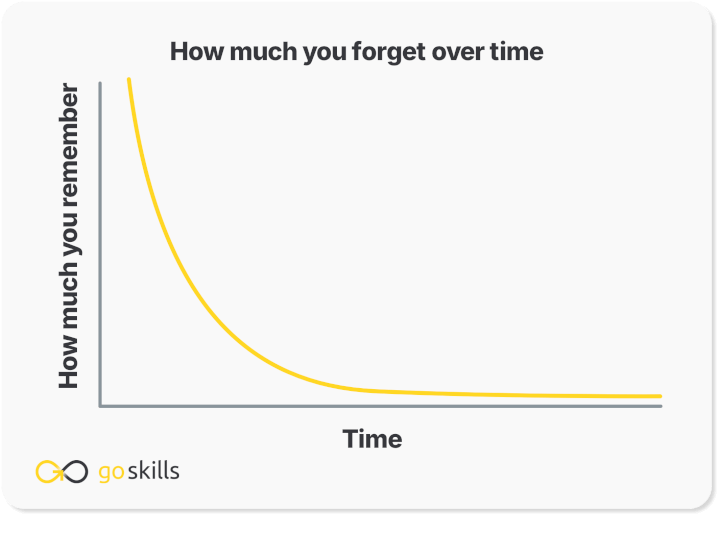
This principle is widely observed. For instance, Duolingo effectively employs spaced repetition by reintroducing vocabulary words and grammar concepts at increasing intervals. If a user struggles with a particular word, it reappears sooner; if mastered, less frequently. This adaptive re-exposure directly aligns with optimal spacing for robust long-term knowledge retention.
Spaced repetition microlearning effect: Spaced repetition is a fundamental microlearning strategy. It optimizes the long-term retention of bite-sized knowledge or skills by scheduling brief, focused review sessions at increasing intervals. This method directly combats the forgetting curve, ensuring learners efficiently commit small chunks of information to long-term memory without overwhelming them. Its focus on short, targeted review makes it perfectly suited for quick, impactful learning moments.
4. Gamified microlearning
In 2009, Microsoft faced a significant challenge in ensuring the quality and accuracy of its software translations across hundreds of languages for products like Windows. Instead of a traditional, tedious review process, they developed an internal, gamified solution: the Language Quality Game.
Employees would engage with bite-sized tasks – reviewing specific translated phrases or dialog boxes. Each review was a small, focused interaction that contributed to a larger quality and improvement goal.
Gamification elements included:
- Points/Scores: Employees earned points for reviewing translations, identifying errors, and suggesting improvements.
- Leaderboards: Individual and team leaderboards displayed top performers, fostering competition and recognition among linguistically talented employees.
- Challenges/Quests: The game often presented specific challenges or "missions" to focus on particular languages or product areas.
- Immediate Feedback: When an employee's suggested correction was accepted or when they identified an error, they received feedback, reinforcing their understanding of quality translation.
The Language Quality Game attracted thousands of voluntary participants who reviewed hundreds of thousands of strings and logged thousands of bug reports. This led to significant improvements in translation quality, showcasing how gamification could turn a typically mundane, large-scale task into an engaging and effective upskilling mechanism.
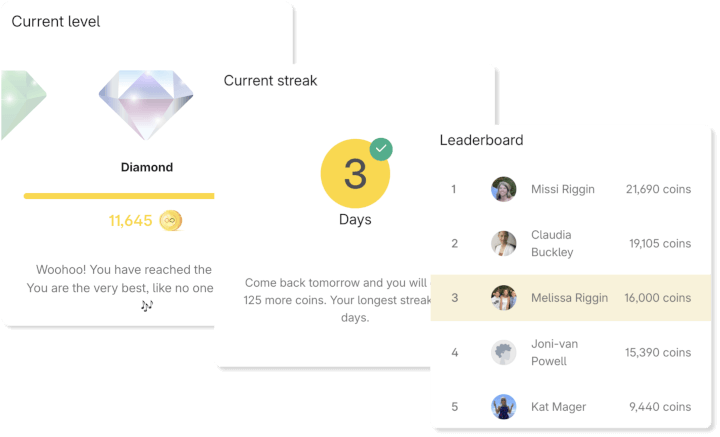
Gamified microlearning effect: Gamified elements are crucial for microlearning because they provide the external motivation and reward systems that encourage consistent engagement with bite-sized content. By turning learning into a game-like experience with immediate feedback, clear progression, and a sense of accomplishment, gamification boosts motivation, fosters healthy competition, and makes the acquisition and reinforcement of small knowledge chunks more enjoyable and, consequently, more effective for long-term retention.
5. Daily challenges / micro-challenges
These involve short, recurring tasks designed to reinforce skills or introduce new content in small, manageable doses. The point is to encourage consistent engagement and habit formation.
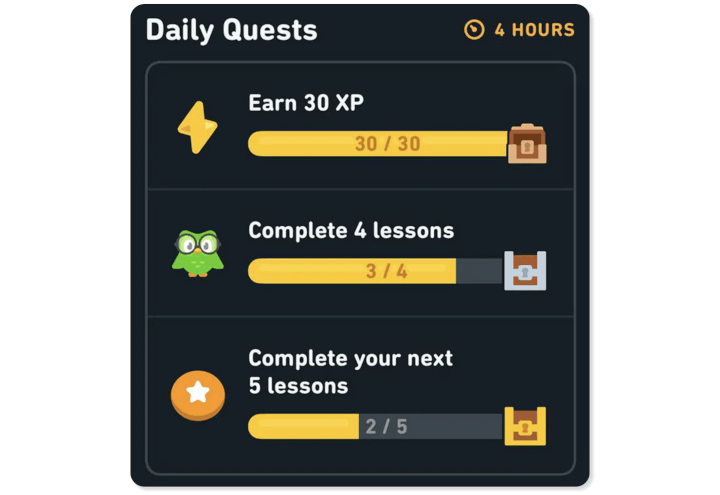
Duolingo excels at implementing daily challenges. Users are presented with a "Daily Quest" or a goal to complete a certain number of lessons or review sessions each day. These short, focused tasks, often taking just 5-10 minutes, might involve practicing vocabulary, completing a grammar exercise, or reviewing past lessons. Immediate feedback, streak counters, and small rewards (like virtual currency or experience points) encourage users to maintain a consistent, bite-sized learning habit.
Daily challenges microlearning effect: Daily challenges are perfectly suited for microlearning because they deliver highly focused, bite-sized content on a consistent, recurring basis. This format helps learning seamlessly integrate into daily routines without significant time commitments.
6. Interactive simulations / mini-scenarios
These are short, focused interactive environments where learners practice decision-making or specific procedures in a safe, controlled setting, receiving immediate feedback on the consequences of their actions.
At GoSkills, our clients often use an AI-powered course builder to develop custom compliance or soft skills training. For instance, you can write a few sentences about a workplace conflict, and ask AI to build a "Conflict Resolution" course module. For example:
- Scenario: A short description of a common workplace conflict (e.g., two colleagues arguing).
- Choice: The learner selects from multiple response options (e.g., "Intervene immediately," "Talk separately").
- Immediate consequence & feedback: The system instantly gives feedback to their choices, guiding reflection and learning from decisions in a simulated environment.
Interactive simulation microlearning effect: By presenting learners with bite-sized, decision-driven challenges and providing immediate feedback on their choices, these simulations enable safe, practical application of knowledge and skills. They bridge the gap between theory and practice, allowing individuals to learn from consequences in a controlled environment.
7. Just-in-time learning / contextual help
When you're navigating, Google Maps provides turn-by-turn directions exactly when you need them. It doesn't show you all 50 turns at once; it shows you the next turn, the next step, just when you're approaching it.
It can also proactively alert you to traffic jams, accidents, or road closures as you approach them, suggesting alternative routes in real-time. This is crucial information delivered precisely when it impacts your immediate task (driving).
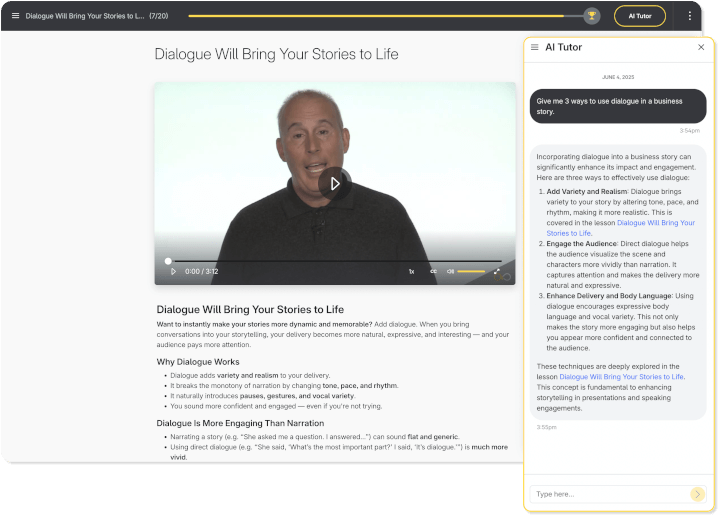
The GoSkills LMS offers a similar just-in-time learning experience with its integrated AI Tutor. Available across all GoSkills and custom courses, this personalized coach provides on-demand guidance. The GoSkills AI tutor can be accessed any time you need help, within any course. Users can click ‘AI Tutor’ within any course to ask questions, from simple clarifications to in-depth inquiries. The AI Tutor instantly delivers explanations, summaries, and clarifications, with its output strictly limited to course material to ensure accuracy.
Microlearning relevance: Google Maps and the GoSkills AI Tutor perfectly illustrate the principles of just-in-time microlearning. Both prevent information overload by delivering highly focused, actionable information precisely at the moment of need. This real-time, targeted support transforms complex learning into manageable, digestible interactions.
8. Text and images
Text can be adapted to microlearning principles by way of cheat sheets, summaries, and other compressed pieces of written information to give learners the most important takeaways from a lesson or other types of learning content.
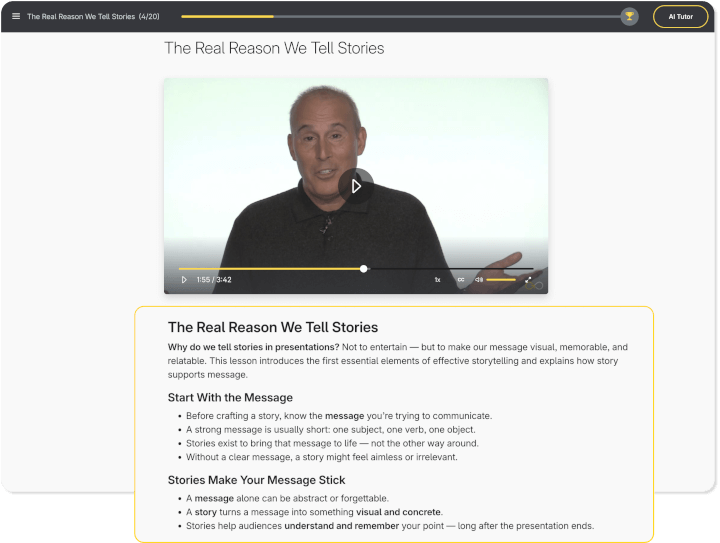
Images are also an important element of microlearning, as they help to illustrate points from the videos or text and form a visual memory for someone learning about a new concept.
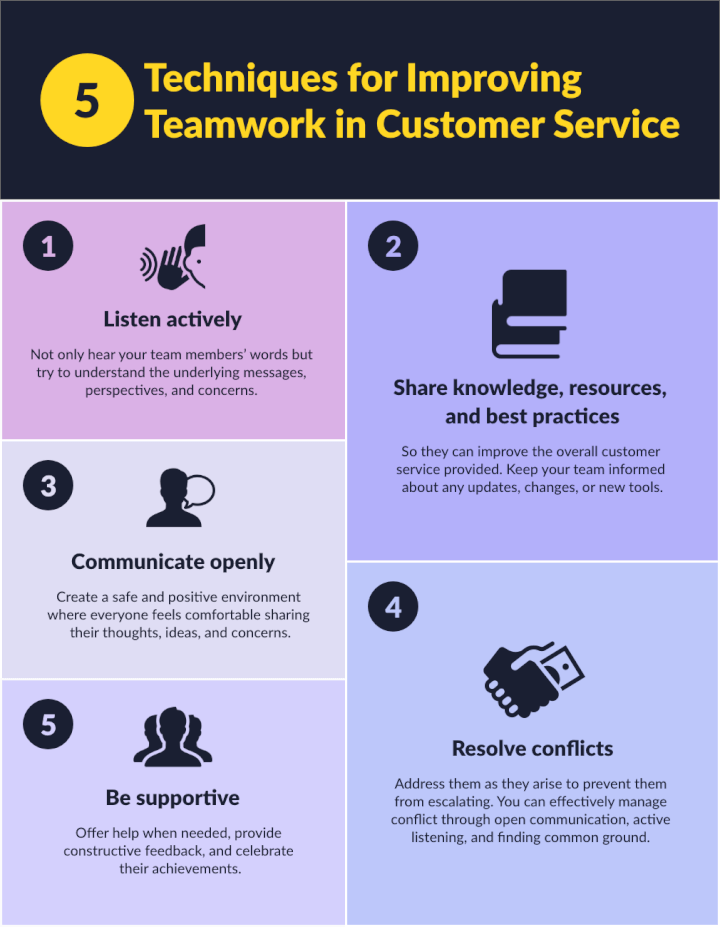
Bonus: Skill tree progression
In the Karate Kid, Daniel LaRusso doesn't immediately learn complex martial arts moves. Instead, Mr. Miyagi has him perform seemingly mundane chores like "wax on, wax off" and “paint the fence”. These repetitive, small tasks taught him fundamental defensive movements, which he later combined to master karate.
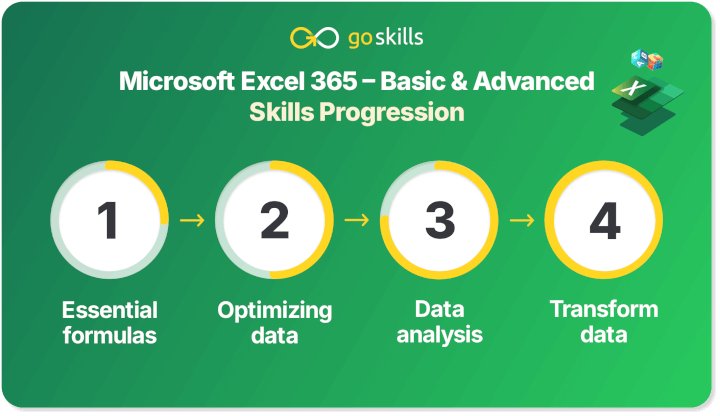
As an example, GoSkills' Microsoft Excel 365 - Basic and Advanced exemplifies skill tree progression, guiding users from beginner to advanced proficiency through a structured path. Composed of 61 mini-lessons, this syllabus incrementally builds concepts, where each lesson directly relies on the previous one. This progressive journey culminates in systematic skill mastery.
Skill tree progression microlearning effect: Skill tree progression perfectly embodies microlearning by breaking down complex subjects or skill sets into small, manageable, and logically sequenced units. Learners acquire new abilities or knowledge in bite-sized, incremental steps, with each piece building directly on previously mastered foundational elements. This structured, progressive approach ensures continuous, digestible learning culminating in comprehensive mastery.
Important microlearning statistics and trends
In 2025, microlearning isn't just a trend; it's a necessity for effective learning and development, directly addressing the challenges of the modern digital landscape. Its core benefits stem from its ability to align with how human attention and cognition function in a perpetually connected world. Consider:
- Cognitive load reductions: The human brain has a limited capacity for processing new information. Microlearning enhances learning efficiency by breaking content into small, digestible chunks, thereby reducing extraneous cognitive load and improving information processing and retention. (source)
- Initial impact of presentations: The most significant student recall (approximately 35% of ideas) occurs within the first 5 minutes of a presentation. Recall drops to its lowest point during the 15- to 20-minute interval. (source)
- Declining digital attention spans: Dr. Gloria Mark's two decades of research show a drastic decline in digital attention spans. In 2004, the average attention span on any screen was around 2.5 minutes. By 2012, it dropped to 75 seconds. In 2023, it dropped to just 47 seconds. (source)
- Minimizing interruption costs: In today's highly interrupt-driven work environments, where workers often need over 23 minutes to fully refocus after an interruption, microlearning provides a solution. Its short, focused modules allow learners to complete meaningful content within brief, uninterrupted windows, preventing the need for costly recovery time from disrupted learning sessions. (source)
This illustrates why GoSkills' microlearning approach is uniquely designed to help modern workers upskill efficiently. It leverages the brain's natural learning patterns while minimizing the impact of today's digital distractions.
Benefits of microlearning for learners
1. A catered learning approach
Because of the modular nature of microlearning courses, learners have the flexibility to focus on lessons that matter the most to them. Each lesson aims to achieve one or a few learning targets. This gives course creators the flexibility to create different types of content for each lesson (e.g., videos, summary sheets, exercise files, quizzes, and games). This variety of content allows learners to take in information in a way that suits them best.
All courses on GoSkills come with a placement quiz, allowing learners to test out of modules they have already mastered and focus on the ones that might need more time.
2. Just-in-time learning
Have you ever looked up a fact to end a dinner table debate? Or looked up Yelp reviews to find the best dishes to order at a restaurant? Or Googled synonyms, so your article sounds more riveting?
If you said yes to any of the above, you would have engaged in some form of just-in-time learning.
What microlearning does is move that concept to the workplace. With access to a microlearning course, learners are equipped to learn skills and find solutions as soon as they need them. This style of learning is particularly useful for employees who need information available on the spot. Employees like this tend to work in industries such as healthcare, retail, or call centers.
Knowing that “orange” was first used to describe the fruit, not the color is a fact that would have been irrelevant to know until its etymology becomes the subject of a dinner table debate. If you learned that fact 30 days before that conversation, it would likely be forgotten.
This brings us to the next benefit – higher retention rates.
3. Higher learning retention
According to Hermann Ebbinghaus’ ‘Forgetting Curve,’ we forget 80 percent of what we have learned in 30 days. This means traditional forms of learning (e.g., one-off seminars, classroom training) may have limited ROI, as well as being costly for businesses and time-consuming for learners. Microlearning can work as standalone training or supplement formal training to extend the lifespan of information.
Microlearning improves retention of information for three key reasons: courses are accessible on-demand, modules are short, and they are designed to be actionable.
As opposed to classroom-based training, microlearning can be accessed online at any time and anywhere. This means information can be obtained at the point of need, thereby increasing its stickiness.
Our brains aren’t made to maintain focus for long periods. Microlearning accommodates that with modules that are intentionally short to match our working memory capacity. This prevents cognitive overload, which is especially useful when learning about difficult topics.
Finally, bite-sized lessons are intentionally designed to meet a narrowly defined learning outcome. This sets up each lesson to be highly actionable. As an example, at GoSkills, learners can view a lesson within a course then test their skills with the exercise file and quiz just seconds after they learn about a topic.
New information in our working memory is temporary. It is either encoded in our long-term memory, decays, or gets replaced. When we attend to and integrate information in our working memory, it becomes encoded in our long-term memory.
4. Mobile learning

This flexibility democratizes learning for those who are especially time-poor (e.g., new parents and commuters).
Axonify’s 2018 report found a high level of microlearning adoption in retail (27 percent), manufacturing & logistics (25 percent) and finance & insurance (22 percent), as well as telecommunications, healthcare, call centers, and pharmaceuticals. The report attributes this to the “disproportionately large concentration of deskless workers” in these industries.
5. Self-paced learning
Think back to the last time you took a course in a group setting. There were probably some concepts you grasped quickly and some that could have benefitted with extra time. Classroom courses are designed to match the average pace of learning in the room. This means that fast learners can lose interest in the content, and slower learners can get stuck playing catch-up. Microlearning eliminates this problem because learners can go through the material at their own pace.
6. More engaging learning content
Each micro lesson sets out to achieve a narrow learning outcome. This gives course creators the flexibility to utilize more engaging methods of transferring information – like videos, storytelling, and games.
Gamification tactics can integrate into microlearning – where learners can earn badges or experience points to make learning more sticky.
Axonify’s 2018 report found that “employees exposed to gameplay and game mechanics participate at a rate of 52 percent more, experiencing average knowledge increases of 27 percent.”
Want to boost your team's success?
Learn why training and development matters (and how to do it right)!
Benefits of microlearning for businesses
7. Higher ROI
A primary concern with online learning is low retention and completion rates. This is not the case with microlearning. The 2018 Axonify report shows that three-quarters of employees (74 percent) voluntarily engage in 106 microlearning training sessions per year.
According to a Software Advice report, more than 50 percent of respondents indicated that they would use their company’s learning tools more if the courses were shorter. According to them, longer courses are not only more challenging to digest and retain, but taking them also gets in the way of their daily work.
The 2018 Axonify report also noted that businesses that allow employees to train on mobile devices saw training frequency increase by 42 percent.
8. Lower development costs
Businesses also benefit from employing microlearning in their learning and development programs. Not only does it have a higher ROI in terms of higher retention rates, but it’s also less costly than traditional forms of training.
According to learning architect Ray Jimenez, Ph.D., learning teams that use microlearning can reduce development costs by 50 percent and increase the speed of development by 300 percent. This is because:
- There are fewer overheads in micro course creation as opposed to traditional offline training. There is no need to rent classrooms, pay for instructors’ time, or purchase classroom equipment.
- It is easier and less time-consuming to update digital information, especially if the content is short and modular. Businesses can replace outdated lessons with updated versions without overhauling the entire course.
9. Ease of distribution
Microlearning modules are far easier to distribute than longer-form elearning modules. Smaller-sized files are more easily uploaded onto the cloud, which means that content can be accessed anywhere.
Conclusion: microlearning - the future of skill development
At its core, a Learning Management System (LMS) is an online platform built to deliver educational content. What truly sets platforms like GoSkills apart is how they fuse this essential technology with cutting-edge pedagogical concepts. This commitment ensures that online learning evolves at the same rapid pace as broader technological advancements.
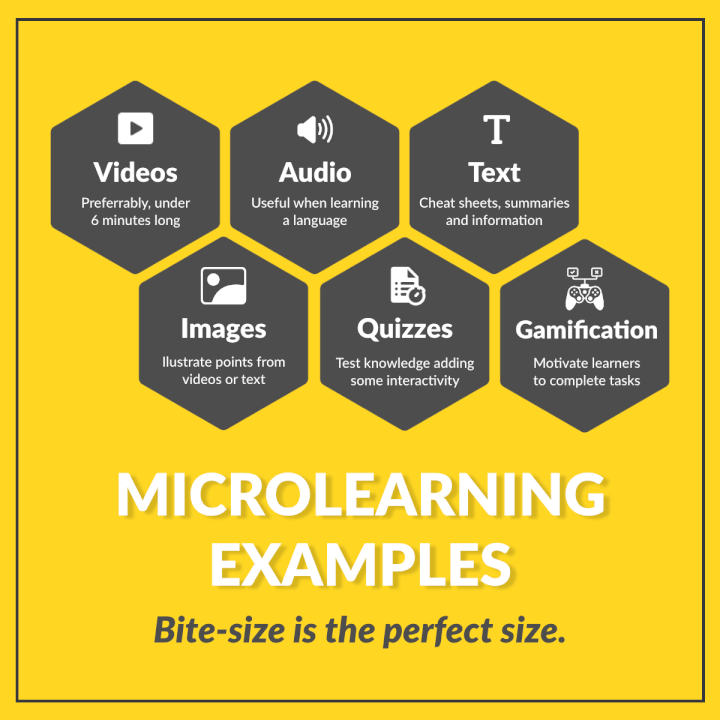
The GoSkills platform fully embraces this powerful approach. Every example discussed in this article — like micro videos, interactive quizzes, spaced repetition, skill tree progression, and just-in-time learning — is seamlessly baked into the GoSkills LMS. This integration ensures that the GoSkills learning experience is genuinely enjoyable and rewarding.
Organizations can apply these microlearning principles to their own training by using the GoSkills course builder, included with every free business account.
For a look at other features stacked within the GoSkills LMS, explore our comprehensive guide.
Boost your business
Get access to free courses and resources to unlock your business' potential — it only takes a minute!
Claim your free business account



